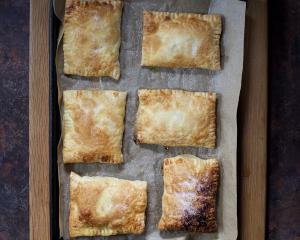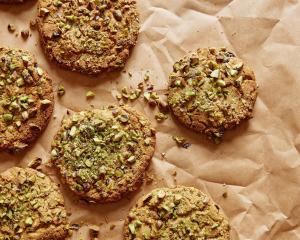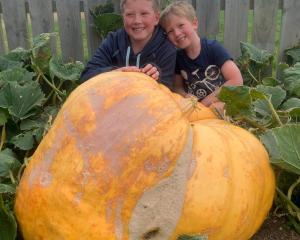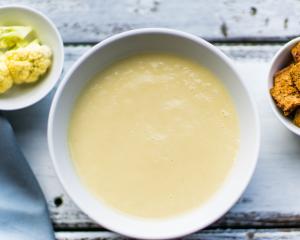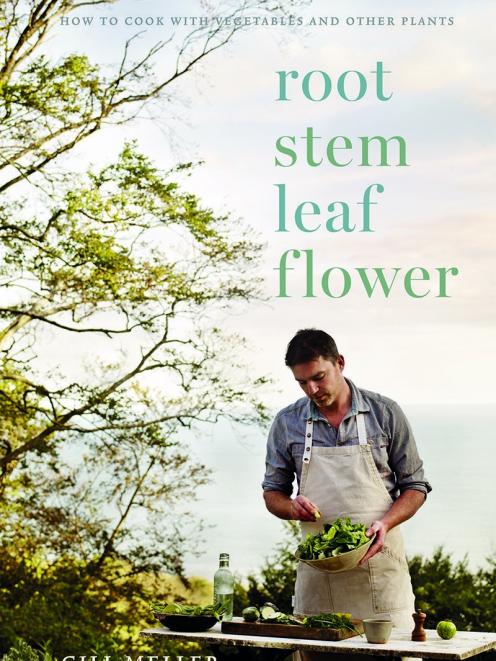
"For a start, you’ll be opening your eyes to a new world of exciting flavours and interesting textures."
Using the freshest locally-grown vegetables means people do not need to waste time overcomplicating their food.
"Fresh vegetables are wonderfully tasty already, just as they are, straight from the ground. Why hide that?"
In his latest book, Root, Stem, Leaf, Flower, Meller celebrates fresh fruit and vegetables in recipes which bring together two or three ingredients in quick and simple ways.
Some dishes are raw - or "lighter and cleaner" as he describes them - but there are also the comforting, hearty and filling recipes for the winter, too.
There are plenty of his favourite desserts - all put fruit and sometimes vegetables centre stage - from cakes and pies to crumbles and ice creams for all seasons.
The book is broken up into chapters following the seasons, and recipes feature key seasonal ingredients from each.
Meller uses cheese, eggs, milk and butter in some of his recipes, but says they can be swapped out or are optional in many cases.
He points out it is not vegetarian oe vegan cookbook, but one for people who want to eat good food and broaden their repertoire of vege-centric recipes.
The cook book is aimedat people who are interested in connecting with the environment, who understand the global challenges the world is facing and want to do their own little bit to help.
"The changes we make now, because the food we eat, and how it’s produced, is intrinsically linked to the state of the natural world."
Meller urges people to slow down, even to stop for a moment, and watch the seasons turn, listen to nature and look out for the honeybee and wild flowers - "they offer a kind of hope".
Some would argue an unbaked cheesecake isn’t a cheesecake at all. I don’t really know what that means or who those people are.
I make both, and they’re equally tasty in their different ways.
This particular version hasn’t got eggs, so doesn’t get baked, but it’s rich nonetheless.
What’s more, it’s fairly quick to make, less fuss. I love the addition of fennel seed and lemon zest here - two flavours that work alongside blackcurrants beautifully. I also like to scatter over fresh lemon thyme before serving.

Blackcurrant and lemon cheesecake with fennel seed and lemon thyme
Serves 8-10
For the base:
150g digestive biscuits
85g unsalted butter
1 Tbsp runny honey
50g jumbo oats, toasted in a dry pan
pinch of fine sea salt
For the filling
300ml double cream
250g full-fat cream cheese
finely grated zest of 1 large lemon and juice of ½
1 tsp fennel seeds, crushed
125g unrefined caster sugar
1 tsp agar flakes
200g blackcurrants
3-4 lemon thyme sprigs, leaves picked
Method
For the base, put the biscuits in a food processor, whiz to fine crumbs, then set aside. Melt the butter and honey together in a pan, then add the crushed digestives, toasted oats, and the salt and mix well. Press the mixture into the base of a 22cm springform tin and chill for 1 hour to set.
Meanwhile, make the filling. Pour the cream into a bowl and add the cream cheese, lemon zest, lemon juice, crushed fennel seeds and 50g of sugar. Using an electric whisk, whisk until the mixture is thick and forms stiff peaks when you lift the beaters.
Spread the creamy mixture over the set biscuit base and return to the fridge.
Place a smallish pan on the hob. Add 3 tablespoons of water and sprinkle over the agar flakes. Warm over a medium heat, until the liquid comes up to a gentle simmer. Use a fork to stir the flakes into the water for 2-3 minutes; this will encourage them to dissolve fully.
Tip the blackcurrants into the pan along with the remaining sugar and half the lemon thyme leaves. Cook gently, stirring often, for about 5 minutes, until the berries are soft but mostly still hold their shape. Remove from the heat and leave to cool to room temperature.
Spoon the blackcurrants along with their sweet juices over the top of the lemon fennel creamy cheese and gently even it all out (you might not need all the juice if there’s a lot).
Place the cheesecake in the fridge for at least 3-4 hours, or until the topping has set completely. Remove from the tin, scatter over the remaining thyme leaves and serve.

I’ve always been fascinated by any form of preserving. To take something living and prevent it from dying - stopping time, rot.
I’m in love with its ancientness and importance. No other form of cookery embodies the symbiotic relationship we once had with nature and the seasons.
Preserving was a beautifully resourceful craft, born out of necessity, out of humble respect and out of a temporal understanding of our environment and what it took to survive within it.
I don’t make this chutney to survive (things have changed), but I can take part of the summer deep into winter, in a glass jar.
Bean apple chutney
Makes 4-5 350g jars
500g runner beans, stringy veins removed and cut into 1cm pieces
1kg Bramley apples, peeled, quartered, cored and roughly chopped
500g ripe tomatoes, roughly chopped
2 onions, roughly chopped
150g sultanas
2 tsp coriander seeds, bashed
1 tsp caraway seeds, bashed
2 cardamom pods, bashed
350g light brown soft sugar
500ml cider vinegar
1 tsp fine sea salt
Method
Put all the ingredients in a preserving pan over a medium heat.
Slowly bring the mixture up to the simmer, stirring regularly until the sugar has dissolved.
Reduce the heat and simmer the chutney for 1½-2 hours, stirring every so often to stop it sticking to the base of the pan. The chutney will thicken as it cooks; you’ll know it’s ready when you can draw a wooden spoon across the bottom of the pan and it leaves a path behind it for a few seconds before the chutney collapses back down. Be extra-careful it doesn’t catch and burn at this point. Remove the chutney from the heat and spoon very carefully into sterilised jars. Seal with the lids and allow to cool.
Store in a cool, dark cupboard for several months before eating – although you can eat it earlier, if you like.

Instead of using sheets of pasta in this lasagne (of sorts), I’m using long, wide, thinly sliced courgette to create the layers. It makes it lighter and ups the vege ante, to boot. If you’ve previously read my recipe for aubergines and roast tomatoes for everything and couldn’t quite decide how best to use it, here’s one idea.
Serves 6
For the white sauce:
750ml whole milk
4 bay leaves
1 onion, sliced
1 celery stick , sliced
a few black peppercorns
60g unsalted butter
60g plain flour
125g cheddar cheese, grated
sea salt and freshly ground black pepper
For the filling:
1 quantity of roast aubergines and tomatoes for everything (see recipe)
6 large courgettes, very thinly sliced lengthways
4-5 Tbsp extra-virgin olive oil
Method
Heat the oven to 200degC.
Make the white sauce. Put the milk, bay leaves, onion, celery and peppercorns in a pan. When the mixture starts to simmer, remove the pan from the heat and set aside to infuse.
Heat the butter in a medium heavy-based pan. Scatter over the flour and, using a wooden spoon, work it into the butter. Cook gently, stirring regularly, for 1 minute. Set a sieve over the pan and pour in half the infused milk. Remove the sieve and work the milk into the butter and flour mixture. Once it thickens, replace the sieve and pour in the remaining milk, then remove the sieve again and beat the sauce with a whisk to a thick, smooth consistency. Add all but a handful of the grated cheese and season with plenty of salt and pepper. Stir well.
Prepare a suitably-sized baking dish or roasting tray — about 25cm square or something like that. Arrange one third of the roast aubergines and tomatoes over the base of the dish. Lay half the courgette slices over the aubergine and tomatoes in a single layer. Sprinkle with a little salt and a twist of black pepper and trickle with half the olive oil. Spoon over half the white sauce. Repeat, arranging another third of the tomatoes and aubergine, followed by the remaining courgette slices and oil, followed by the second half of the white sauce. Arrange the last of the roast vegetables over the top and scatter over the remaining cheese. Bake for 30-35 minutes, until the sauce is bubbling, and the top is golden and delicious-looking. Allow to cool for 10 minutes before serving with a green salad and some good bread.
I don’t usually write recipes without an end, like this one. Generally, I’m pretty specific about where you’ll end up, but it’s kind of interesting, for both of us, to leave that part up to you, occasionally. I’ve called the recipe "Aubergines and roast tomatoes for everything" for that reason — there are infinite possibilities.
I like the fact that I’ll never really know where you’ll go with it. It’s like a recipe in a bottle, floating off into the unknown.

Serves 4
1kg ripe mixed heritage tomatoes, halved or quartered depending on size
2 aubergines, sliced into 2-3cm rounds
1 garlic bulb, cloves separated and peeled
2 tsp fennel seeds, lightly crushed
good pinch of chilli flakes
2-3 rosemary sprigs
4 Tbsp extra-virgin olive oil, plus extra to serve
1 small bunch of basil, leaves picked and ribboned
½ small handful of flat-leaf parsley, leaves picked and finely chopped
sea salt and freshly ground black pepper
Method
Heat the oven to 150degC/130degC fan.
Place the tomatoes cut sides upwards on a large baking tray.
Add the aubergine slices and scatter over the garlic cloves.
Sprinkle in the fennel seeds and chilli flakes and tear over the rosemary leaves.
Trickle everything with the olive oil and season really well with salt and pepper.
Roast the vegetables for 1 hour 20 minutes, carefully stirring once or twice, without breaking up the tomatoes too much, until the tomatoes are soft and blistered and the aubergine is lovely and golden, and crisp around the edges.
Scatter the herbs over the roasted vegetables.


